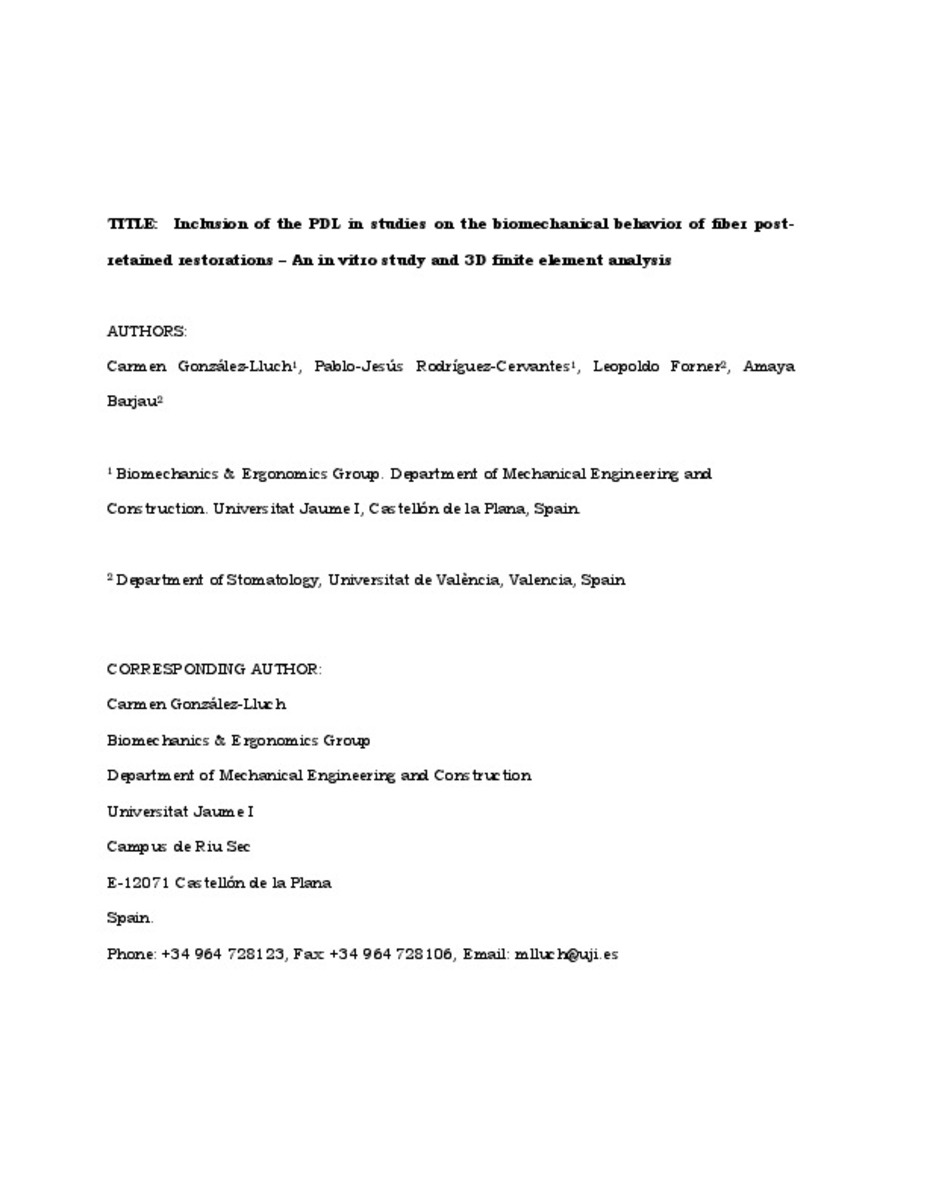Mostrar el registro sencillo del ítem
Inclusion of the PDL in studies on the biomechanical behavior of fiber post- retained restorations
| dc.contributor.author | González-Lluch, Carmen | |
| dc.contributor.author | Rodríguez Cervantes, Pablo Jesús | |
| dc.contributor.author | Forner Navarro, Leopoldo | |
| dc.contributor.author | Barjau Escribano, Amaya | |
| dc.date.accessioned | 2016-05-11T07:39:34Z | |
| dc.date.available | 2016-05-11T07:39:34Z | |
| dc.date.issued | 2016-03 | |
| dc.identifier.citation | GONZÁLEZ LLUCH, Carmen; RODRÍGUEZ CERVANTES, Pablo Jesús; FORNER NAVARRO, Leopoldo; BARJAU ESCRIBANO, Amaya. Inclusion of the PDL in studies on the biomechanical behavior of fiber post- retained restorations - An in vitro study and 3D finite element analysis. Proceeedings of the Institution of Mechanical Engineers. Part H, Journal of Engineering in Medicine (2016), v. 230, n. 3, pp. 230-238 | ca_CA |
| dc.identifier.uri | http://hdl.handle.net/10234/159534 | |
| dc.description.abstract | Endodontically treated teeth are known to have reduced structural strength. Periodontal ligament (PDL) may influence fracture resistance. The purpose of this study was to assess the influence of including the PDL in biomechanical studies about endodontically treated and restored teeth. Forty human maxillary central incisors were treated endodontically and randomly divided into four groups: non-crowned (with and without an artificial ligament) and crowned (with and without an artificial ligament) with glass-ceramic crowns. All groups received prefabricated glass fiber posts and a composite resin core. Specimens were tested, under a flexural-compressive load, until failure occurred. The failure mode was registered for all specimens. The failure loads were recorded and analyzed using an ANOVA test (P␣<0␣.05). These results were compared with those predicted by a finite element model. The ANOVA did not show significant differences between the use of crown on the failure load (P=0␣. ) and the use of PDL (P=0.185). A cohesive mode in crown appeared in crowned teeth and in core in non-crowned group. For non-crowned teeth, and adhesive failure occurred along the cement-enamel junction with a slight tendency in specimens without PDL. Furthermore, an unfavorable failure mode affecting partially the root with no differences regarding to non- crown specimens. In crowned teeth, the tendency was an adhesive failure along the cement- enamel junction. The model predicted a distribution of the safety factor consistent with these results. The present study showed that inclusion of PDL is not particularly important on biomechanical behaviour of post-retained restorations. However, we recommend its inclusion in fatigue studies. | ca_CA |
| dc.description.sponsorShip | The authors thank the University Jaume I for its financial support throughout the project P1·1B2012-10 | ca_CA |
| dc.format.extent | 25 p. | ca_CA |
| dc.format.mimetype | application/pdf | ca_CA |
| dc.language.iso | eng | ca_CA |
| dc.publisher | Sage | ca_CA |
| dc.relation.isPartOf | Proceeedings of the Institution of Mechanical Engineers. Part H, Journal of Engineering in Medicine (2016), v. 230, n. 3 | ca_CA |
| dc.rights.uri | http://rightsstatements.org/vocab/CNE/1.0/ | * |
| dc.subject | Biomechanics | ca_CA |
| dc.subject | Fiber posts | ca_CA |
| dc.subject | Finite element model | ca_CA |
| dc.subject | Oral rehabilitation | ca_CA |
| dc.subject | Periodontal ligament | ca_CA |
| dc.subject | Restorative dentistry | ca_CA |
| dc.title | Inclusion of the PDL in studies on the biomechanical behavior of fiber post- retained restorations | ca_CA |
| dc.title.alternative | An in vitro study and 3D finite element analysis | ca_CA |
| dc.type | info:eu-repo/semantics/article | ca_CA |
| dc.identifier.doi | http://dx.doi.org/10.1177/0954411916630006 | |
| dc.rights.accessRights | info:eu-repo/semantics/openAccess | ca_CA |
| dc.relation.publisherVersion | http://pih.sagepub.com/content/230/3.toc | ca_CA |
| dc.edition | Postprint | ca_CA |
Ficheros en el ítem
Este ítem aparece en la(s) siguiente(s) colección(ones)
-
EMC_Articles [807]







